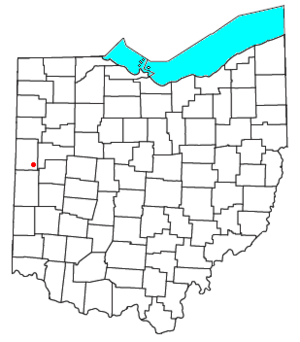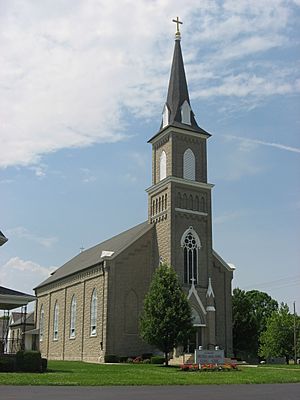Cassella, Ohio facts for kids
Cassella is a small, unincorporated community in Mercer County, Ohio, United States. An "unincorporated community" means it's a group of homes and buildings that isn't officially a town or city with its own local government. Cassella is located in Marion Township, at an elevation of about 955 feet (291 meters) above sea level.
You can find Cassella where State Route 119 meets Cassella-Montezuma Road. It's south of Celina, which is the main city in Mercer County. Other nearby places include Maria Stein, about 3 miles (4.8 km) to the east, Carthagena, 2 miles (3.2 km) north, and St. Henry, 4 miles (6.4 km) to the west.
Contents
The Land of the Cross-Tipped Churches
Cassella is part of a special area in western Ohio known as the "Land of the Cross-Tipped Churches." This region is famous for its many beautiful Catholic churches. The community of Cassella grew up around the Nativity of the Blessed Virgin Mary Catholic Church. This church was first started in 1847, and its current building was built in 1858.
How Cassella Got Its Name
The name "Cassella" comes from the church itself. When German settlers first lived here, they called the church "Cappella," which means "chapel" in Latin. Over time, this name changed slightly and became "Cassella." In the past, the community was also known by other names like "Dogtown," "Frogtown," and "Marysville." The name "Cassella" was officially chosen in 1963 by the United States Board on Geographic Names.
History of Cassella
Cassella had its own post office for a while, opening on April 22, 1878. However, it closed on June 15, 1905, and after that, mail for Cassella went through the post office in St. Henry.
The community also had schools. There were two former parish schools near the church, and at one point, Cassella had public schools too.
The Church Fire of 1888
A big event in Cassella's history was a fire in 1888 that almost completely destroyed the Nativity Church. The brick walls of the church survived, but the inside was ruined. The walls were finally repaired in 1915, making the church strong again.
Cassella Today
Today, Cassella is still a small community. The Nativity Catholic Church remains the center of the area. In 1979, the church and its rectory (the house where the priest lives) were added to the National Register of Historic Places. This means they are recognized as important historical sites, just like many other Catholic churches and buildings in the Land of the Cross-Tipped Churches.



